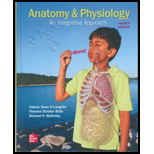
Introduction:
Respiration is a process, in which food is broken down into simpler components by releasing energy. The respiratory system consists of organs that participate in the exchange of gases. Respiration includes two processes; breathing (external respiration) and
Answer to Problem 1DYKB
Correct answer:
Respiration normally requires nervous system, muscular system, and respiratory system. Therefore, option d. is correct.
Explanation of Solution
Reason for the correct statement:
Option d. is given as “All of these are correct”. Respiration involves inhalation and exhalation. Lungs, nostrils, nasal cavity, and windpipe are parts of the respiratory system that are involved in respiration. Respiration also involves muscular system. Muscle cells function in the contraction and relaxation of the diaphragm and thoracic cavity. Muscle contraction is promoted by stimuli. These stimuli are transmitted through neurons. Hence, respiration normally requires nervous system, muscular system, and respiratory system.
Hence, option d. is correct.
Reasons for the incorrect statements:
Option a. is given as “respiratory system”. Apart from the respiratory system, respiration also requires muscular and nervous system. Hence, option a. is incorrect.
Option b. is given as “muscular system”. Apart from muscular system, respiration also requires nervous system and respiratory system. Hence, option b. is incorrect.
Option c. is given as “nervous system”. Apart from the nervous system, respiration also requires muscular system and respiratory system. Hence, option c. is incorrect.
Hence, options a., b., and c. are incorrect.
Respiration involves the functioning of the respiratory system, nervous system, and muscular system. All these systems function simultaneously to perform respiration.
Want to see more full solutions like this?
Chapter 23 Solutions
Anatomy & Physiology: An Integrative Approach
- Give examples of fat soluble and non-fat soluble hormonesarrow_forwardJust click view full document and register so you can see the whole document. how do i access this. following from the previous question; https://www.bartleby.com/questions-and-answers/hi-hi-with-this-unit-assessment-psy4406-tp4-report-assessment-material-case-stydu-ms-alecia-moore.-o/5e09906a-5101-4297-a8f7-49449b0bb5a7. on Google this image comes up and i have signed/ payed for the service and unable to access the full document. are you able to copy and past to this response. please see the screenshot from google page. unfortunality its not allowing me attch the image can you please show me the mathmetic calculation/ workout for the reult sectionarrow_forwardIn tabular form, differentiate between reversible and irreversible cell injury.arrow_forward
- 1.)What cross will result in half homozygous dominant offspring and half heterozygous offspring? 2.) What cross will result in all heterozygous offspring?arrow_forward1.Steroids like testosterone and estrogen are nonpolar and large (~18 carbons). Steroids diffuse through membranes without transporters. Compare and contrast the remaining substances and circle the three substances that can diffuse through a membrane the fastest, without a transporter. Put a square around the other substance that can also diffuse through a membrane (1000x slower but also without a transporter). Molecule Steroid H+ CO₂ Glucose (C6H12O6) H₂O Na+ N₂ Size (Small/Big) Big Nonpolar/Polar/ Nonpolar lonizedarrow_forwardwhat are the answer from the bookarrow_forward
- what is lung cancer why plants removes liquid water intead water vapoursarrow_forward*Example 2: Tracing the path of an autosomal dominant trait Trait: Neurofibromatosis Forms of the trait: The dominant form is neurofibromatosis, caused by the production of an abnormal form of the protein neurofibromin. Affected individuals show spots of abnormal skin pigmentation and non-cancerous tumors that can interfere with the nervous system and cause blindness. Some tumors can convert to a cancerous form. i The recessive form is a normal protein - in other words, no neurofibromatosis.moovi A typical pedigree for a family that carries neurofibromatosis is shown below. Note that carriers are not indicated with half-colored shapes in this chart. Use the letter "N" to indicate the dominant neurofibromatosis allele, and the letter "n" for the normal allele. Nn nn nn 2 nn Nn A 3 N-arrow_forwardI want to be a super nutrition guy what u guys like recommend mearrow_forward
 Comprehensive Medical Assisting: Administrative a...NursingISBN:9781305964792Author:Wilburta Q. Lindh, Carol D. Tamparo, Barbara M. Dahl, Julie Morris, Cindy CorreaPublisher:Cengage Learning
Comprehensive Medical Assisting: Administrative a...NursingISBN:9781305964792Author:Wilburta Q. Lindh, Carol D. Tamparo, Barbara M. Dahl, Julie Morris, Cindy CorreaPublisher:Cengage Learning Medical Terminology for Health Professions, Spira...Health & NutritionISBN:9781305634350Author:Ann Ehrlich, Carol L. Schroeder, Laura Ehrlich, Katrina A. SchroederPublisher:Cengage LearningBasic Clinical Lab Competencies for Respiratory C...NursingISBN:9781285244662Author:WhitePublisher:CengageEssentials of Pharmacology for Health ProfessionsNursingISBN:9781305441620Author:WOODROWPublisher:Cengage
Medical Terminology for Health Professions, Spira...Health & NutritionISBN:9781305634350Author:Ann Ehrlich, Carol L. Schroeder, Laura Ehrlich, Katrina A. SchroederPublisher:Cengage LearningBasic Clinical Lab Competencies for Respiratory C...NursingISBN:9781285244662Author:WhitePublisher:CengageEssentials of Pharmacology for Health ProfessionsNursingISBN:9781305441620Author:WOODROWPublisher:Cengage





